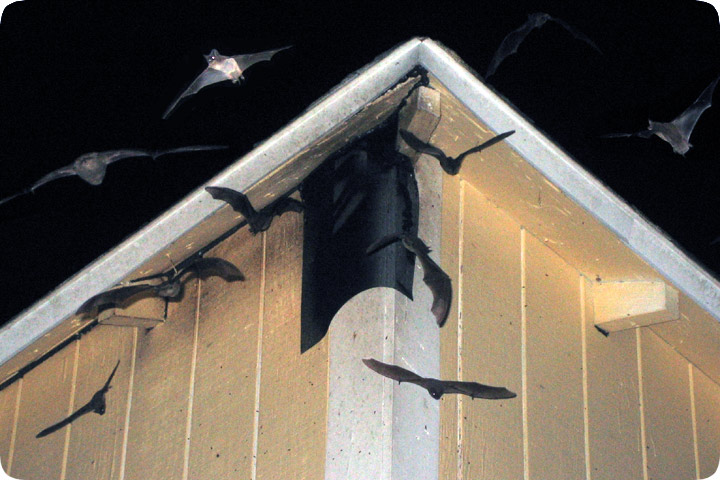-
info@aaanimalcontrol.com
Call us for help in your town
Humane Wildlife Education
Bat Exclusion from Attic of Home

However, bats are very peculiar when it comes to landing. They don't purposely fly right to a hole and dive right in. Instead, they circle and circle and circle. Then once they decide that they want to fly in, it often takes several tries to get it right. This of course depends on the architecture of the hole, but bats seem to need to approach the hole just right in order to get the proper momentum to enter, but not too fast that they incur injury. At least, this is my guess, because even when holes are wide open, they'll often approach, briefly land at the hole, then drop off only to try again. The situation is further complicated by large numbers of bats. It appears that once a bat has landed in the hole, that it briefly blocks the entryway, preventing another bat from swooping in. Then there's the whole matter of air traffic control. The bats don't want to collide mid-air, so they keep tabs on each other and approach with caution. Thus, even when you've got hundreds of bats such as in this case, they won't all fly at the hole at once.
It's rare to get any photos of bats on the wing, and any shot with multiple fliers in the frame means a whole lot in the area. It was like a bat storm around me. This particular house had many holes, pretty much across the entire perimeter of the structure. This is not unusual. However, bats often adopt another odd behavior. Even when they've got multiple entry points, they'll often just stick to one specific spot. Actually, I don't know why I say this is odd. Every living creature does this sort of thing. I could enter my house through any number of doors or windows, but I always use the same door. I guess bats do the same thing. Why do the bats and I always use the same door? Because it's the best door. The very best, and no other door is good enough for my regal body to pass through, that's why. However, if someone boards up my favorite door, I guess I could use a different door. Bats will do the same, and that's why it's important to close every single possible spot on a house through which bats might enter, even if they're only seen flying in and out of one particular spot.
Do it yourself: Visit my How To Get Rid of Bats page for tips and advice.
Get professional help: Visit my Nationwide Pro Directory of wildlife removal experts.
For more wildlife stories, click my Wildlife Blog or click my below banner to hire a local trapper.

If you notice a bat or two coming from the attic of your home or loft in your building, you may be wondering how to best get them out and keep them out. While there are potential chemicals and traps that can be used, you need to be careful about how you place them if you have domestic animals in the home too. The most effective way to get rid of a bat is to get them out of their home-sweet-home and never let them come back via exclusion.
What is Bat Exclusion?
Bat exclusion is using a piece of netting to cover the opening where the bats are coming into the attic. With the bat exclusion in place, the bat will drop down in order to fly out but cannot crawl back into the opening again. This one-way door system doesn’t kill them; it relocates them so they can find another building or attic to belong to. In addition, it is not harmful to anyone living in the home or pets either.
What About the Babies?
In many states, you cannot use the exclusion technique during the summer due to the fact that there could be baby bats inside that are flightless and there are laws in effect to protect them during this time.
In most cases, bats enter your attic in order to have a safe place to have babies, also called pups. Bats like to live in large groups as well so there will be a few bats in your attic instead of just one or two. While the pups are flightless, the mothers are nursing them so if you block out the mother, you kill the baby through starvation. When this separation does happen, the babies will get hungry and begin to crawl around and, in some cases, can end up inside your home by following a vent or crack in the ceiling along the chimney. If they do starve and die, you will then have the odor of dead bats in your home and that will stink.
What Type of Damage Can Bats do While in the Attic?
If left alone, bats can be very hard on an attic. Their diet consists mostly of insects so they do cut down on the number of mosquitos and other insects that can be aggravating for humans. Bats like to stay inside during the daylight and go out between dusk and dawn. During the day, they may poop up to thirty times. If you have a large colony in your attic, the piles of poop are going to mount up and cause a huge problem. In addition to that, mold will start growing around where the piles of poop are on the floor. That’s why it’s important to get rid of them as soon as you notice their presence.




















